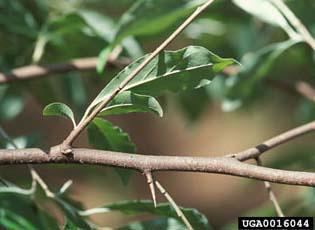Elaeagnus umbellata Thunb. (ITIS)
Autumn olive, Elaeagnus, Oleaster, Japanese silverberry
Asia (Munger 2003)
1830 (Munger 2003)
Introduced as an ornamental; cultivated for wildlife habitat and erosion control (Fordham et al. 2003)
Displaces native species (Munger 2003)

Autumn olive, twigs/shoots with thorns and leaves in April
Photo by James H. Miller; USDA, Forest Service
Find more images
Spotlights
Distribution / Maps / Survey Status
Videos
All Resources
Selected Resources
The section below contains highly relevant resources for this species, organized by source.
Council or Task Force
Partnership
Federal Government
State and Local Government
Fordham, I.M, R.H. Zimmerman, B.L. Black, B.M. Clevidence, and E.R. Wiley. 2003. Autumn olive: a potential alternative crop In: J. Maas (Ed.), XXVI International Horticultural Congress: Berry Crop Breeding, Production and Utilization for a New Century (Acta Horticulturae No. 626, pp. 429-431). Leuven, Belgium: International Society for Horticultural Science.
Integrated Taxonomic Information System. Elaeagnus umbellata. [Accessed Aug 10, 2023].
Kurtz, Cassandra M, Mark H Hansen, and issuing body United States. Forest Service. Northern Research Station. An Assessment of Autumn Olive in Northern U.S. Forests [PDF, 5 pages]. Newtown Square, Pa: United States Department of Agriculture, Forest Service, Northern Research Station, 2016.
Munger, G.T. 2003. Elaeagnus umbellata. In: Fire Effects Information System. U.S. Department of Agriculture, Forest Service, Rocky Mountain Research Station, Fire Sciences Laboratory.
